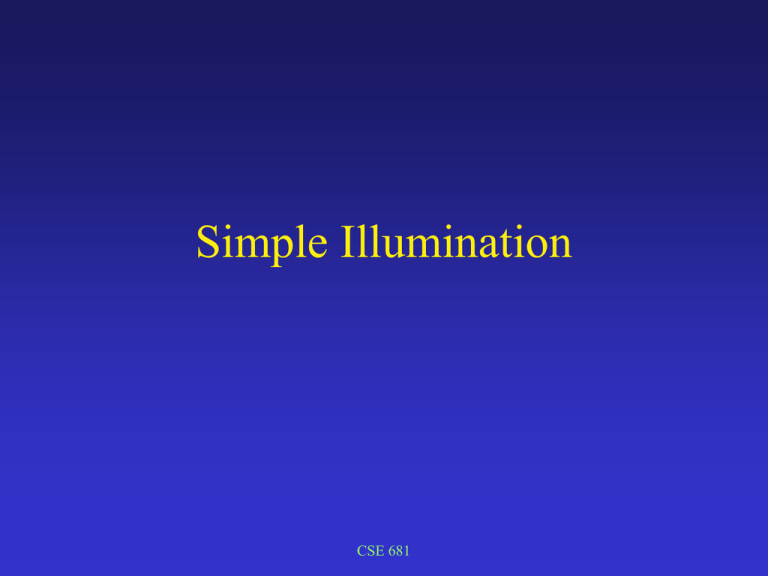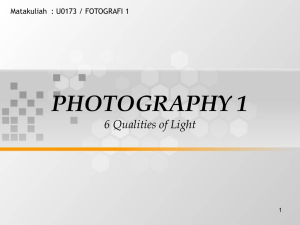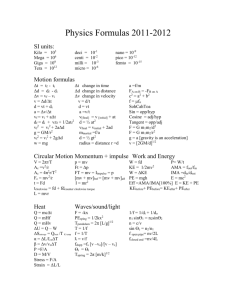ppt
advertisement

Simple Illumination CSE 681 Types Ambient lighting • indirect light hitting the object by reflecting off of other surfaces - color of surface reflecting it Diffuse light reflecting off the object by being absorbed by the surface (subsurface scattering) and reemitted equally in all directions Specular light reflecting immediately off the surface - directional and color of light source CSE 681 Ambient Radiosity - calculate amount of each surface visible from given point on object and propagate reflected light through environment Approximation - use constant as amount of indirect Light hitting each surface and • Add to diffuse light hitting object Or • Reflect portion of ambient light (OpenGL) CSE 681 Diffuse Light hitting surface direct from light source Scatters equally in all direction (get absorbed in surface and emerges in random direction) Because it is absorbed, the reflected light is the color of the object CSE 681 Diffuse Light View independent Reflectance function Amount of incoming light is function of incoming direction CSE 681 Diffuse Calculate area of delta area projected onto plane perpendicular to direction of light rays Projected area = sin(q) = cos(f) = N·L L f N ( N L)colorobject dA q L CSE 681 Specular Light hitting surface direct from light source It reflects directly off of surface of object and is reflected primarily at angle from normal equal to angle coming in (incident angle) Because it is not absorbed, the reflected light is the color of the light source CSE 681 Specular Phong Model for Specular Reflection: Calculate direction of reglection and use cosine falloff as view deviates from that direction Direction of Reflection view dependent Light Reflectance function Deviation from direction of reflection CSE 681 Specular N (E·N) N (E·N)N - E E E·N RE (E·N)N - E (E·N)N + (E·N)N - E 2(E·N)N - E = RE CSE 681 Specular N RE – refection vector of E L RL – refection vector of L RL RE q q E Raise it to a power (material property) to control how fast the specular component falls off. Multiply by color of light. CSE 681 Cos(q) = E· RL = L· RE ( E RL ) f colorlight OR ( L RE ) f colorlight Illumination Model C Kd (a I ( N L))cobj K s ( RE L) f I (1,1,1) Assume single, white light source Add coefficient of reflectivity for diffuse, Kd , and specular light, Ks Add intensity of light, I Assume ambient term is incoming light to be diffusely reflected CSE 681 Multiple Light Sources C K d (a i [d i I i ( N Li )])cobj K s i [d i I i ( RE Li ) f ci ] Add in the effects of a light source if and only if the face is a FRONT FACE with respect to the light based on sign of N·L di = 0 if light is behind face = 1 if light is in front of face Assume multiple colored light sources Diffuse - color of object (cobj) Specular - color of light source (ci) Use L· RE to avoid recomputing reflection vector CSE 681 Some of the Options Ambient term wavelength dependent Each light contributes to ambient light: ambienti Light has different diffuse and specular intensities Calculate Light reflection vector instead of Eye reflection vector Use bisecting vector between L and E, compare to N for specular (see next slide) Reflection coefficients wavelength dependent (separate r, g, b values) Light color affects diffuse color CSE 681 Specular Alternative specular calculation N L a H - bisects angle made by L and E H Compare H to N (cosine of angle) E q/2 = a ( H N ) f colorlight H = (E+L)/|E+L| CSE 681


